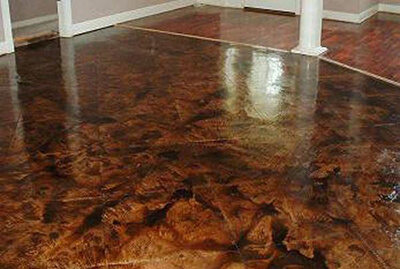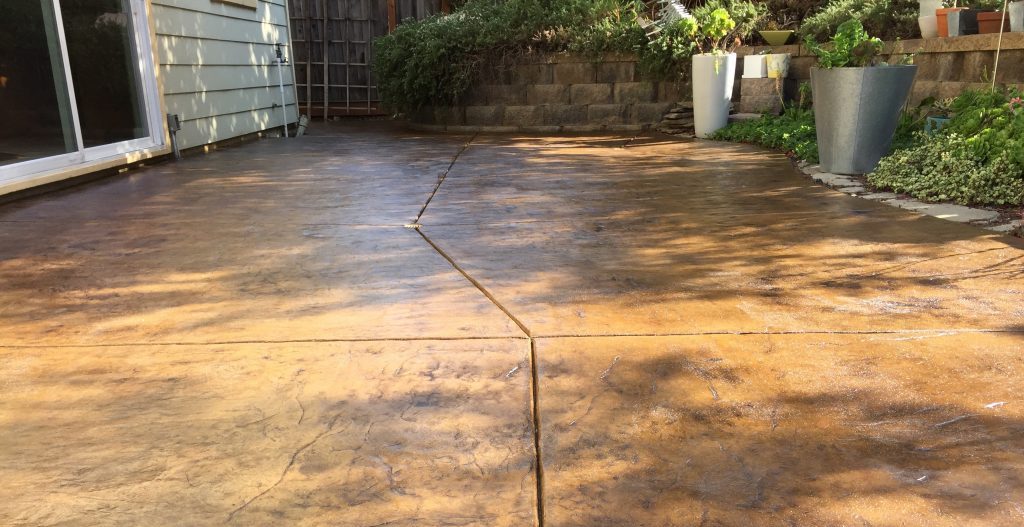Hiring guide for selecting the best stained concrete company
Understanding the Different Types of Stained Concrete for Your Following Job
Stained concrete offers numerous options that satisfy various aesthetic and functional requirements. Each kind provides unique characteristics that influence the last appearance and longevity of the surface area. Understanding these differences is vital for anyone planning a job. From rich, chemical reactions of acid-based stains to the dynamic uniformity of solid color stains, the choices can substantially impact the outcome. What elements should one take into consideration when picking the perfect stain for their particular requirements?
Overview of Stained Concrete
Stained concrete acts as a functional floor covering alternative that can enhance the visual appeal of various spaces. This strategy includes using a tinting agent to the surface of existing concrete, enabling a wide range of layout possibilities. Stained concrete is prominent in both domestic and industrial environments, offering a sturdy and low-maintenance remedy that can imitate the appearance of all-natural products like stone or tile.
The discoloration procedure can be performed making use of water-based or solvent-based products, each offering distinctive visual impacts. The final appearance is affected by factors such as the initial concrete surface area, the kind of discolor used, and the application method. Stained concrete not only enhances interiors and outsides yet additionally advertises sustainability by renewing existing concrete structures. Because of this, it has actually obtained grip amongst homeowners and developers seeking both capability and style in their floor covering options.
Acid-Based Stains: Features and Advantages

Unique Shade Variations
Concrete surfaces can transform considerably with the application of acid-based stains, which offer an abundant palette of distinct shade variants. These stains penetrate the concrete, responding chemically to produce lively earth tones that range from deep browns and reds to soft environment-friendlies and blues. The resulting shades are usually variegated, producing an all-natural, marble-like appearance that boosts the concrete's character. Each application yields distinct outcomes as a result of variants in the concrete's composition and the staining method used, making every task distinct. Additionally, acid-based stains can be layered or incorporated with other methods to develop personalized layouts, permitting personal expression. This adaptability makes acid-based stains a prominent choice for both domestic and business applications.
Chemical Responses Described
While several elements contribute to the performance of acid-based stains, the underlying chain reaction play a necessary role in their one-of-a-kind qualities and benefits. These stains mainly consist of water, acid, and metallic salts. When put on concrete, the acid responds with the calcium hydroxide in the concrete, producing a chemical improvement that results in long-term shade changes. The metal salts penetrate the surface area and bond with the concrete, permitting a wide variety of tones and tones. This response not only improves visual allure but additionally supplies durability, making the shade immune to fading and wear. Additionally, acid-based stains can create a variegated finish that mimics all-natural rock, additional improving their popularity for attractive concrete applications.
Surface Prep Work Significance
Accomplishing perfect results with acid-based stains rests on thorough surface preparation. This vital action assurances that the concrete surface is tidy, complimentary of impurities, and correctly profiled for perfect discolor absorption. Any type of existing sealants, dust, or oils can hinder the chemical reaction that produces the desired shade and coating, leading to unequal or uneven outcomes.
Prior to using the stain, the concrete should be mechanically cleaned up or stress cleaned, followed by a complete inspection for fractures or flaws that may need repair. Additionally, confirming the surface is sufficiently dried out will certainly enhance stain adherence. By focusing on these preparatory procedures, the durability and vibrancy of acid-based stains can be significantly improved, resulting in a much more visually pleasing and resilient finish.
Water-Based Stains: Functions and Benefits

Water-based stains pass through the concrete, offering a much more clear coating that highlights the natural appearance and variations of the surface under. They are readily available in a broad range of colors, permitting creative adaptability in layout. In addition, water-based stains are simpler to clean up, needing just water and soap, which simplifies the application procedure.
Their quick drying time boosts effectiveness, making them a sensible option for both do it yourself fanatics and professionals. Overall, water-based stains give an attractive combination of visual flexibility and user-friendly homes, making them a popular alternative for concrete enhancement projects.
Strong Color Stains: Vivid Alternatives for a Vibrant Look
Solid color stains supply an efficient service for those looking for to create a vibrant and vibrant aesthetic on concrete surface areas. These stains offer a consistent coloration that can drastically boost the aesthetic allure of floorings, outdoor patios, and driveways. Available in a large spectrum of colors, solid shade stains allow for creative expression, dealing with different style choices.
Among the key advantages of strong color stains is their ability to conceal blemishes, giving a fresh and polished seek to aging concrete - local stained concrete. In addition, their formula normally includes UV-resistant buildings, making certain durability and shade retention also in harsh climate condition
Application is straightforward, needing minimal preparation of the concrete surface. Once used, solid color stains can be sealed for added defense and shine, further raising their aesthetic high quality. With their lively options, solid shade stains are an excellent choice for those going for an impactful and cohesive style.
Semi-Transparent Stains: Attaining Deepness and Dimension
Semi-transparent stains supply an unique method to enhancing concrete surface areas by offering deepness and measurement with numerous shade choices. Recognizing the application techniques is necessary for attaining the desired effect, while appropriate maintenance techniques ensure durability. This section will check out these essential facets to maximize the benefits of semi-transparent staining.
Shade Options Available
A variety of color choices exists for semi-transparent stains, permitting homeowners and developers to enhance the natural appeal of concrete surface areas. These stains are available in a range of hues, from earthy tones like browns and terracottas to vibrant colors such as blues and eco-friendlies. The semi-transparent nature of these stains enables the underlying concrete to reveal via, producing an one-of-a-kind depth and measurement that can match different layout looks. Furthermore, incorporating various colors can create custom tones, enabling a tailored seek each task. This adaptability makes semi-transparent stains a prominent selection for both exterior and interior applications, as they can harmonize with surrounding components while including aesthetic rate of interest to plain concrete.
Application Strategies Explained
To accomplish the desired depth and dimension with semi-transparent stains, correct application techniques are necessary. Surface area prep work is critical; the concrete must be tidy and free of any type of contaminants. This commonly includes power cleaning and repairing any fractures. Next off, selecting the best applicator, such as a sprayer, roller, or brush, can affect the final appearance. Sprayers enable for an extra even application, while rollers can assist achieve appearance. It is crucial to apply the discolor in thin, even layers, enabling each layer to completely dry before including an additional. Controling the application technique, such as varying stress or utilizing different devices, can develop special effects. Ultimately, sealing the stained surface boosts the vibrancy of the colors while giving protection.
Upkeep Best Practices
Regular maintenance is important for protecting the charm and stability of surfaces treated with semi-transparent stains. To preserve these surface areas, regular cleaning is vital. Using a pH-neutral cleaner and a soft-bristle mop will assist eliminate dust and debris without damaging the tarnish. It is a good idea to prevent rough chemicals, as they can break down the tarnish's appearance. Additionally, regular resealing every one to three years can shield against wear and fading. This procedure involves cleaning up the surface area completely and using a suitable sealant developed for stained concrete. Property owners must additionally keep track of for any signs of discoloration or damage and address these issues quickly to assure lasting vibrancy and toughness. Adhering to these finest practices will certainly improve the overall life-span of semi-transparent stained surface areas.
Impacts and Techniques: Personalizing Your Stained Concrete
Tailoring stained concrete involves a variety of techniques that improve both aesthetics and capability. Amongst these techniques, layering various discolor shades can create depth and complexity, enabling for one-of-a-kind aesthetic results. Techniques such as acid discoloration supply a variegated appearance, while water-based stains offer an extra uniform look.
Furthermore, incorporating decorative patterns, such as stenciling or engraving, can better customize the surface, adding detailed layouts that satisfy individual preferences. Texturing the concrete, whether through marking or mop finishes, presents tactile elements that not just boost grip however visit the website also boost aesthetic passion.
Applying sealants can intensify the color vibrancy and give security versus wear. Customization methods prolong past mere color; they can change a typical concrete piece right into a spectacular prime focus, making it ideal for both household and business spaces. Through mindful selection of results and methods, stained concrete can attain a really customized look.
Upkeep and Long Life of Stained Surfaces
Stained concrete surfaces are recognized for their longevity and visual allure, preserving their stability is crucial for making sure longevity. Regular cleansing is crucial; sweeping and mopping with a pH-neutral cleaner helps prevent dirt accumulation and staining. In addition, official statement applying a sealant every few years can secure the surface area from dampness, chemicals, and UV damages, thus enhancing its life-span.
It is likewise crucial to deal with any kind of fractures or chips quickly. Little repairs can reduce more wear and tear, protecting the visual and structural top quality of the surface. For outdoor stained concrete, seasonal maintenance, such as eliminating snow and ice, is required to stop surface area damages from freeze-thaw cycles.
Often Asked Questions
Can I Stain Existing Concrete Surfaces or Only Brand-new Ones?
The concern of whether existing concrete surfaces can be stained emerges often. It is without a doubt possible to stain both new and old concrete, provided the surface area is adequately ready and devoid of impurities for excellent bond.
For how long Does the Discoloration Refine Generally Take?
The discoloration process normally takes one to 3 days, relying on variables such as surface area preparation, sort of stain, and climate conditions. stained concrete floors. Healing time see this might extend past preliminary application, influencing the general period substantially
Is Stained Concrete Safe for Outdoor Usage?
Stained concrete is generally risk-free for outdoor use, supplied it is appropriately sealed. This sealing protects versus wetness and UV damage, making certain toughness and safety, while likewise boosting the aesthetic charm of exterior spaces.
Can I Apply Several Spot Layers for Different Results?
Using multiple discolor layers can accomplish diverse effects on stained concrete. Nevertheless, it is vital to assure compatibility in between stains and permit proper drying time between applications to prevent unplanned responses or discoloration.
Are There Any Type Of Color Limitations for Stained Concrete?
Color limitations for stained concrete largely depend on the sort of discolor utilized, with water-based stains using a more comprehensive palette compared to acid-based stains. stained concrete company. Nonetheless, attaining vivid shades might call for mindful selection and application techniques